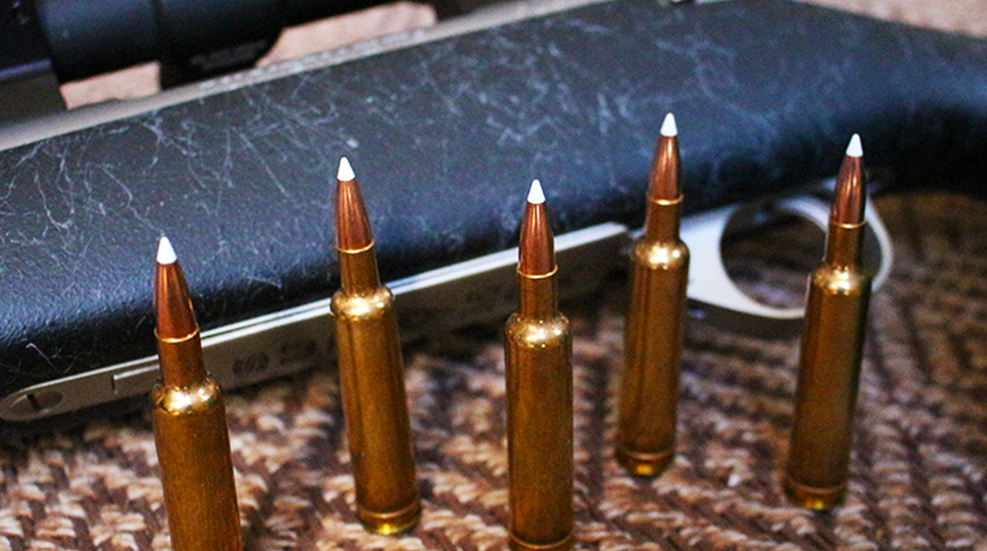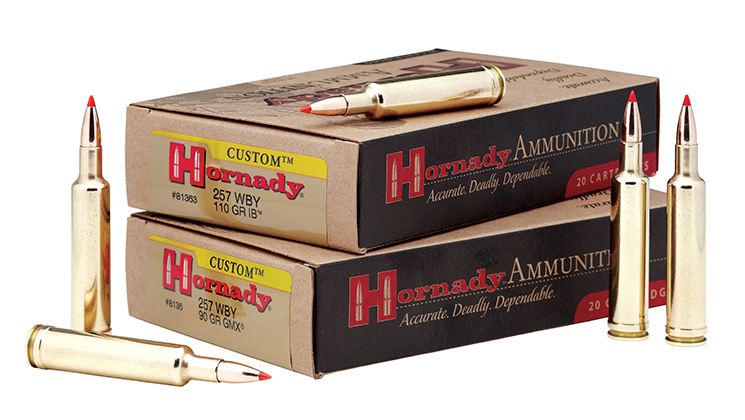https://www.americanhunter.org/articles/2018/1/19/behind-the-bullet-257-weatherby-magnum/by PHILIP MASSARO posted on January 19, 2018

When you hear the word ‘Weatherby,’ speed immediately comes to mind. The signature double-radius shoulder, the belt of brass which hearkens back to its roots in the Holland & Holland cartridges, and huge case capacity are all attributes of the Weatherby series of cartridges. Roy Weatherby began developing the line of cartridges that would bear his surname during the latter part of the World War II, using the .300 H&H Magnum as a basis for his designs.
Weatherby initially shortened the case length to roughly 2.5 inches—allowing them to function perfectly in a standard long-action receiver—for his cartridges below .30 caliber. While the .270 Weatherby Magnum is believed to be the first of the line, the .257 was one of the earlier developments, bettering the ballistics of the .257 Roberts, .250/3000 Savage and then-wildcat .25-06 Remington, by a considerable amount.
The desire to drive a .25 caliber bullet as fast as possible is rather evident throughout cartridge history. The sedate .25-20 Winchester came to light in the mid-1890s, and that bore diameter got a serious facelift in 1915 with the release of the .250/3000 Savage—it was the first commercial cartridge to break the 3,000 fps barrier (albeit with a light-for-caliber 87-grain bullet), and its effectiveness on deer and similar-sized game remains evident to this day. The .257 Roberts—a necked down 7x57mm Mauser case—gave even more case capacity, and corresponding higher velocities. Both are classics, and both are sound designs.
However, the .257 Weatherby Magnum took things to an entirely different place. It will drive even the heaviest .25 caliber bullets—the 117- and 120-grain slugs—to a muzzle velocity of between 3,300 and 3,400 fps, depending on barrel length and manufacturer. This results in a cartridge with a very flat trajectory, and all sorts of kinetic energy for its bore diameter. The belt on the .257 Weatherby serves no purpose whatsoever—it is nothing more than a carryover from the H&H parent case. The double radius shoulder handles all the headspace duties, so that brass belt is for looks alone.
While all that velocity is a benefit for the trajectory, the case capacity of the .257 Weatherby does come with some issues. One, the huge powder charges—often approaching 75 grains of powder—and high velocity will raise hell with the throat of your barrel. The best option to extend barrel life is to do your best to keep that barrel cool—give it some time between shots from the bench. Two, the cartridge is seriously overbore, in fact it’s one of the most overbore on the market. During load development with my buddy’s .257 Weatherby, we could see a bright flame, even under the noon sun, with every shot. A long barrel, say 26 inches or so, will help to get that huge powder column burned within its confines, so you can maximize the capabilities of Roy’s design.
Weatherby ammunition has been, for decades, made by Norma of Sweden, and that’s a good thing. High quality, uniform brass aids in accuracy, and the tolerances that Norma adheres to means very, very few cartridges will fail to function properly—I’ve never had a single misfire from a Norma cartridge. You’ll want a premium bullet for anything larger than a deer, as the high velocities will definitely put a strain on your projectile, especially on the closer shots.
Factory ammunition is available from Weatherby, Nosler, Hornady and Norma, and bullet weights run from 90 grains up to 120 grains, with all sorts of choices for the hunter. The Hornady 90-grain GMX is a sweet monometal affair, fully capable of withstanding the high impact velocities this cartridge can generate. Cruising at 3,550 fps, this should settle the score pretty quickly, and as there’s no jacket or core to separate, penetration will be guaranteed. Hornady also offers the 110-grain ELD-X bullet, which has proven to be ridiculously accurate in many of my rifles (albeit in different calibers), and should be the same in this caliber. Nosler offers the AccuBond, Ballistic Tip and Partition, so you can have a choice of performance suited to the game you’re after. Weatherby lists, among others such as the Nosler projectiles, the Barnes TTSX bullet at 80 and 100 grains; not only are these bullets strong, but the lighter weight will allow for an increase in velocity.

Should you choose to handload the .257 Weatherby, you’re definitely going to want to choose the slowest burning powders, and spark it with a good large rifle magnum primer. RL-25, IMR7828, and other slow burners have all given good results in the .257, though I will note that bullet seating depth can play an important role in finding the best accuracy.
The limits of the .257 Weatherby are essentially up to the shooter. Roy Weatherby used this cartridge to kill a rhinoceros—though I would highly advise against such utter foolishness—but I feel that elk and perhaps moose represent a better top end of game animals, again, when mated with premium bullets. Nonetheless, if you’re a fan of the quarter-bores, the .257 Weatherby Magnum will perform above and beyond what you’d normally expect from this bore diameter.